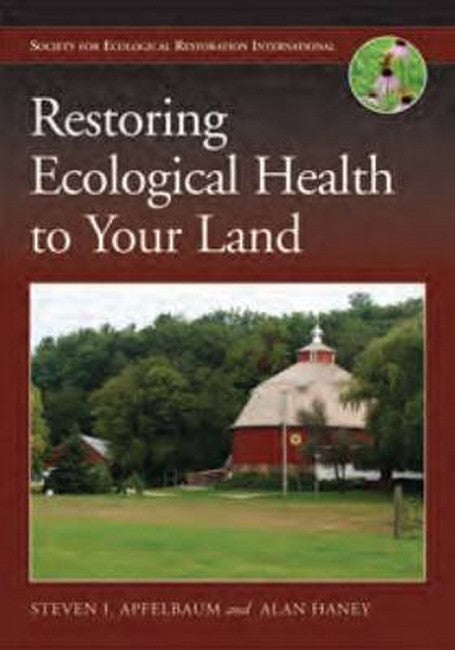Preface
Introduction
PART I. Principles of Ecological Restoration
Chapter 1. Connecting with the Land: The Story of Stone Prairie Farm
-Exploring the Landscape
-Developing a Plan
-Getting Started
-Scaling Up
-Learning to Work with Nature
-Principles Learned from the Stone Prairie Experience
-Learning by Doing
-The Necessity of Stewardship
-Joy of Success
-Conclusions
Chapter 2. Ecological Restoration: An Overview
-Ecosystems
Assessing the Health of Ecosystems
Indicators of Healthy Ecosystems
Special Importance of Diversity
-Ten-Step Process for Ecological Restoration
Step One: Mapping and Inventory
Step Two: Investigate the History of the Landscape
Step Three: Interpretation of Landscape Changes
Step Four: Develop Realistic Goals and Objectives
Step Five: Prepare a Plan
Step Six: Develop and Initiate a Monitoring Program
Step Seven: Implement the Plan
Step Eight: Document Changes and Maintain Records
Step Nine: Periodically Reevaluate the Program
Step Ten: Communicate and Educate
-Conclusion
Chapter 3. Developing a Restoration Plan
-The Restoration Process
Step One: Inventory and Mapping
Step Two: Investigate the History of the Landscape
Step Three: Interpretation of Landscape Changes
Step Four: Develop Realistic Goals and Objectives
Step Five: Prepare a Plan
Step Six: Develop and Initiate a Monitoring Program
Step Seven: Implement the Plan
Step Eight. Document Changes and Maintain Records
-Conclusion
Chapter 4. Implementing Restoration
-Working at the Right Scale
-Where to Start
-Working With and Not Against Nature
-Recruiting Volunteers and Hiring Professional Help
-Restoration Success and Nature's Clock
Availability vs. Phenology
Reading Phenology: What to Look For
Knowing When It Is Too Late
Throwing Everything at the Land?
Patience, Persistence, and Long-term Perspectives
-Commonly Employed Techniques
Hydrology
Chemical Challenges
Biological Techniques
Site Preparation
Seeding and Planting
Control of Woody Vegetation
Use of Fire
-A Management Program
-Conclusions
Chapter 5. Monitoring Progress
-Affirming Measurable Objectives
-Basic Monitoring Techniques
Light Quality and Quantity
Plant Community and Vegetation
Hydrology
Faunal Monitoring
-Other Benefits of Monitoring
-Is There Ever an Endpoint?
-Conclusions
PART II. Applying Restoration to Different Types of Ecosystems
Chapter 6. Grassland Restoration
-Historic Grasslands in North America
-Grassland Fauna
-Vegetation
-Fire
-Stressors
-Market and Policy Changes
-Restoration Practices
Mixed-grass and Short-grass Prairie Restoration
Tallgrass Prairie Restoration
Choice of Species
Caring for New Prairie
Prescribed Fire
Control of Woody Invasives
-Conclusions
Chapter 7. Restoring Forest Ecosystems
-The Challenge of Restoring Forested Ecosystems
-Applying the Principles of Restoration
Examples Across North America
Longleaf-slash Pine Forests
Bottomland Hardwood Forests
Oak-pine and Loblolly-short-leaf Pine Forests
Oak-hickory Forests and Northern Hardwood Forests
Boreal Forests
Savannas
Pacific Evergreen Forests
-Conclusions
Chapter 8. Wetland Restoration
-Wetland Form and Function
-Planning Wetland Restoration
-Regulations and Legal Definitions
-Different Types of Wetlands
-Substrates
-Water Quality
-Hydrology
Classification of Wetlands
-Physical Gradients and Biological Change
-Stressors
-Restorations Strategies and Process
Chapter 9. Restoring Streams
-Underlying Problems
-Some Principles
-The Process of Stream Restoration
-Conclusion
Chapter 10. Restoring Deserts
-What Is a Desert
-Unique Biological Adaptations
-Stressors and Impacts
-Restorations Strategies
-Conclusions
Species List
Glossary
Notes
Index
Introduction
PART I. Principles of Ecological Restoration
Chapter 1. Connecting with the Land: The Story of Stone Prairie Farm
-Exploring the Landscape
-Developing a Plan
-Getting Started
-Scaling Up
-Learning to Work with Nature
-Principles Learned from the Stone Prairie Experience
-Learning by Doing
-The Necessity of Stewardship
-Joy of Success
-Conclusions
Chapter 2. Ecological Restoration: An Overview
-Ecosystems
Assessing the Health of Ecosystems
Indicators of Healthy Ecosystems
Special Importance of Diversity
-Ten-Step Process for Ecological Restoration
Step One: Mapping and Inventory
Step Two: Investigate the History of the Landscape
Step Three: Interpretation of Landscape Changes
Step Four: Develop Realistic Goals and Objectives
Step Five: Prepare a Plan
Step Six: Develop and Initiate a Monitoring Program
Step Seven: Implement the Plan
Step Eight: Document Changes and Maintain Records
Step Nine: Periodically Reevaluate the Program
Step Ten: Communicate and Educate
-Conclusion
Chapter 3. Developing a Restoration Plan
-The Restoration Process
Step One: Inventory and Mapping
Step Two: Investigate the History of the Landscape
Step Three: Interpretation of Landscape Changes
Step Four: Develop Realistic Goals and Objectives
Step Five: Prepare a Plan
Step Six: Develop and Initiate a Monitoring Program
Step Seven: Implement the Plan
Step Eight. Document Changes and Maintain Records
-Conclusion
Chapter 4. Implementing Restoration
-Working at the Right Scale
-Where to Start
-Working With and Not Against Nature
-Recruiting Volunteers and Hiring Professional Help
-Restoration Success and Nature's Clock
Availability vs. Phenology
Reading Phenology: What to Look For
Knowing When It Is Too Late
Throwing Everything at the Land?
Patience, Persistence, and Long-term Perspectives
-Commonly Employed Techniques
Hydrology
Chemical Challenges
Biological Techniques
Site Preparation
Seeding and Planting
Control of Woody Vegetation
Use of Fire
-A Management Program
-Conclusions
Chapter 5. Monitoring Progress
-Affirming Measurable Objectives
-Basic Monitoring Techniques
Light Quality and Quantity
Plant Community and Vegetation
Hydrology
Faunal Monitoring
-Other Benefits of Monitoring
-Is There Ever an Endpoint?
-Conclusions
PART II. Applying Restoration to Different Types of Ecosystems
Chapter 6. Grassland Restoration
-Historic Grasslands in North America
-Grassland Fauna
-Vegetation
-Fire
-Stressors
-Market and Policy Changes
-Restoration Practices
Mixed-grass and Short-grass Prairie Restoration
Tallgrass Prairie Restoration
Choice of Species
Caring for New Prairie
Prescribed Fire
Control of Woody Invasives
-Conclusions
Chapter 7. Restoring Forest Ecosystems
-The Challenge of Restoring Forested Ecosystems
-Applying the Principles of Restoration
Examples Across North America
Longleaf-slash Pine Forests
Bottomland Hardwood Forests
Oak-pine and Loblolly-short-leaf Pine Forests
Oak-hickory Forests and Northern Hardwood Forests
Boreal Forests
Savannas
Pacific Evergreen Forests
-Conclusions
Chapter 8. Wetland Restoration
-Wetland Form and Function
-Planning Wetland Restoration
-Regulations and Legal Definitions
-Different Types of Wetlands
-Substrates
-Water Quality
-Hydrology
Classification of Wetlands
-Physical Gradients and Biological Change
-Stressors
-Restorations Strategies and Process
Chapter 9. Restoring Streams
-Underlying Problems
-Some Principles
-The Process of Stream Restoration
-Conclusion
Chapter 10. Restoring Deserts
-What Is a Desert
-Unique Biological Adaptations
-Stressors and Impacts
-Restorations Strategies
-Conclusions
Species List
Glossary
Notes
Index

